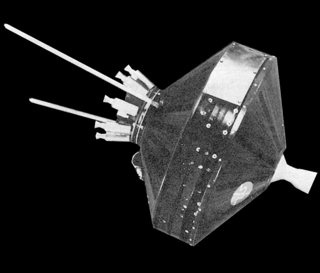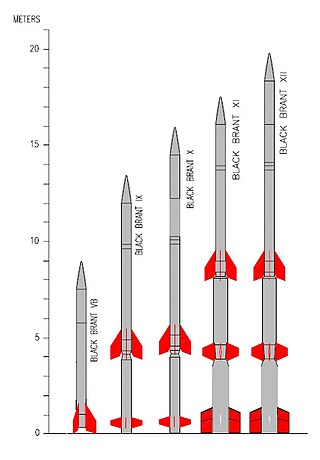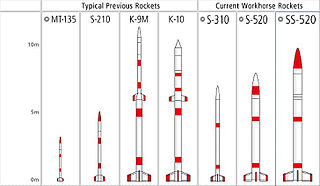History
The first launching site of the sounding rockets in Poland was Błędowska Desert, where since 1958 to 1963, the rockets of different types had been launched; among others RD and Rasko. During a flight, the biological experiment with earlier trained two white mouses was conducted (the RM-2D rocket achieved the altitude of 1,580 meters).
Since 1965 to April 1970, the Meteor-1 rockets had been launched from "spaceport" located 5 km from Ustka town. This programme had been continued to 1974, when rockets were bearing out from the area of experimental center founded there during the years of the Second World War, located on west side of Łeba town. Currently, it is preserved in the museum (the starting place with ramp and the radar bases).
There was 224 flights of "Meteor-1" rocket series (including prototypes). The valuable data both meteorological and connected with rocket techniques were collected and analyzed as the result of these researches.
The "Meteor-1", "Meteor-2H" and "Meteor 2K" (the largest civilian rocket developed in Poland) were single-stage rockets. The "Meteor-3" was a two-stage rocket, developed from "Meteor 1".
| Meteor 1 | Meteor 2H | Meteor 2K | Meteor 3 |
|---|
| maximum altitude | 40 km | 68 km | 100 km | 65 km |
| takeoff thrust | 14 kN | 24 kN | 52 kN | 14 kN |
| diameter | 12 cm | 35 cm | 35 cm | 12 cm |
| length | 2.5 m | 4.5 m | 4.3 m | 4.3 m |
|
Meteor rockets had been launched from Łeba and Ustka. Five Meteor rockets missions were conducted around 1970 from Zingst, in the former Eastern Germany. The programme of flights of Meteor-2 was finished during the same year, when Poland started to participate in Interkosmos research, using the Vertical rockets, which were derived from R-14 missile.
Meteor-1
One stage, but two units rocket called "Meteor-1" had the length of 2,470 mm and the initial mass of 32.5 kg. The flight lasted for 80 seconds and reaching at the peak altitude of 36.5 km. The motor ignite for 2–3 seconds and reached the maximum velocity of 1,100 meters per seconds. In 1965, 6 rockets of "Meteor-1" type was launched and after this time: 12 in 1966, 40 in 1967, 45 in 1968, 36 in 1969, 34 in 1970 and 4 in 1971.
The charge of metal dipoles was released by rockets and this material had later been observed on radar screens. It was the base of derivation of winds strength in the stratosphere and winds directions in the same atmospheric layer. After experiments that had been conducted in the years 1965–1966, during "The Year of the Quiet Sun", a cyclic pattern of variation in case of directions of these atmospheric flows was concluded.

Pioneer 1 was an American space probe, the first under the auspices of NASA, which was launched by a Thor-Able rocket on 11 October 1958. It was intended to orbit the Moon and make scientific measurements, but due to a guidance error failed to achieve lunar orbit and was ultimately destroyed upon reentering Earth's atmosphere. The flight, which lasted 43 hours and reached an apogee of 113,800 km, was the second and most successful of the three Thor-Able space probes.

Pioneer P-3 was intended to be a lunar orbiter probe, but the mission failed shortly after launch. The objectives were to place a highly instrumented probe in lunar orbit, to investigate the environment between the Earth and Moon, and to develop technology for controlling and maneuvering spacecraft from Earth. It was equipped to take images of the lunar surface with a television-like system, estimate the Moon's mass and topography of the poles, record the distribution and velocity of micrometeorites, and study radiation, magnetic fields, and low frequency electromagnetic waves in space. A mid-course propulsion system and injection rocket would have been the first United States self-contained propulsion system capable of operation many months after launch at great distances from Earth and the first U.S. tests of maneuvering a satellite in space.

Pioneer P-30 was intended to be a lunar orbiter probe, but the mission failed shortly after launch on September 25, 1960. The objectives were to place a highly instrumented probe in lunar orbit, to investigate the environment between the Earth and Moon, and to develop technology for controlling and maneuvering spacecraft from Earth. It was equipped to estimate the Moon's mass and topography of the poles, record the distribution and velocity of micrometeorites, and study radiation, magnetic fields, and low frequency electromagnetic waves in space. A mid-course propulsion system and injection rocket would have been the first United States self-contained propulsion system capable of operation many months after launch at great distances from Earth and the first U.S. tests of maneuvering a satellite in space.

The Aerobee rocket was one of the United States' most produced and productive sounding rockets. Developed by the Aerojet Corporation, the Aerobee was designed to combine the altitude and launching capability of the V-2 with the cost effectiveness and mass production of the WAC Corporal. More than 1000 Aerobees were launched between 1947 and 1985, returning vast amounts of astronomical, physical, aeronomical, and biomedical data.

A sounding rocket or rocketsonde, sometimes called a research rocket or a suborbital rocket, is an instrument-carrying rocket designed to take measurements and perform scientific experiments during its sub-orbital flight. The rockets are used to launch instruments from 48 to 145 km above the surface of the Earth, the altitude generally between weather balloons and satellites; the maximum altitude for balloons is about 40 km and the minimum for satellites is approximately 121 km. Certain sounding rockets have an apogee between 1,000 and 1,500 km, such as the Black Brant X and XII, which is the maximum apogee of their class. Sounding rockets often use military surplus rocket motors. NASA routinely flies the Terrier Mk 70 boosted Improved Orion, lifting 270–450-kg (600–1,000-pound) payloads into the exoatmospheric region between 97 and 201 km.

AS-202 was the second uncrewed, suborbital test flight of a production Block I Apollo command and service module launched with the Saturn IB launch vehicle. It was launched on August 25, 1966, and was the first flight which included the spacecraft guidance, navigation control system and fuel cells. The success of this flight enabled the Apollo program to judge the Block I spacecraft and Saturn IB ready to carry men into orbit on the next mission, AS-204.

The Black Brant is a family of Canadian-designed sounding rockets originally built by Bristol Aerospace, since absorbed by Magellan Aerospace in Winnipeg, Manitoba. Over 800 Black Brants of various versions have been launched since they were first produced in 1961, and the type remains one of the most popular sounding rockets. They have been repeatedly used by the Canadian Space Agency and NASA.
Between 1933 and 1964 numerous rocket experiments were carried out in the area of Cuxhaven, Germany.
Seliger Rocket is the designation for the sounding rockets of the Berthold Seliger Forschungs- und Entwicklungsgesellschaft mbH. They were
- A single-stage rocket with a length of 3.4 metres and a takeoff thrust of 50 kN. This rocket was first launched on November 19, 1962, near Cuxhaven and reached a height of 40 km.
- A two-stage rocket with a length of 6 metres and a takeoff thrust of 50 kN. This rocket was first launched on February 7, 1963, and reached a height of 80 km.
- A three-stage rocket with a length of 12.8 metres, a diameter of 0.56 metres and a takeoff thrust of 50 kN. This rocket was first launched on May 2, 1963, with reduced fuel and reached an altitude of 120 km. Later with maximum fuel it reached a height of 150 km.
The Mohr Rocket was a sounding rocket developed by Ernst Mohr in Wuppertal, Germany.

Loki, officially designated 76mm HEAA Rocket T220, was an American unguided anti-aircraft rocket based on the German Taifun. Like the Taifun, Loki never saw service in its original role, but later found widespread use as a sounding rocket. It was so successful in this role that several advanced versions were developed on the basic Loki layout, including the final Super Loki.

S-Series is a fleet of sounding rockets funded by the Japan Aerospace Exploration Agency (JAXA) that have been in service since the late 1960s. Manufactured by IHI Aerospace and operated by the Institute of Space and Astronautical Science (ISAS). The nomenclature of the S-Series rockets is the number of "S"s indicates the number of stages, and the following number details the diameter of the craft in millimeters. For example, the S-310 is a single stage rocket with a diameter of 310 mm.

Arcas was the designation of an American sounding rocket, developed by the Atlantic Research Corp., Alexandria, Va.

The Aggregat series was a set of ballistic missile designs developed in 1933–1945 by a research program of Nazi Germany's Army (Heer). Its greatest success was the A4, more commonly known as the V2.

Romanian Cosmonautics and Aeronautics Association, also known as ARCAspace, is an aerospace company based in Râmnicu Vâlcea, Romania. It builds rockets, high-altitude balloons, and unmanned aerial vehicles. It was founded in 1999 as a non-governmental organization in Romania by the Romanian engineer and entrepreneur Dumitru Popescu and other rocket and aeronautics enthusiasts. Since then, ARCA has launched two stratospheric rockets and four large-scale stratospheric balloons including a cluster balloon. It was awarded two governmental contracts with the Romanian government and one contract with the European Space Agency. ARCASpace is currently developing a three-stage, semi-reusable steam-powered rocket called EcoRocket and in 2022 has shifted its business model to Asteroid mining.

The Civilian Space eXploration Team, also known as the CSXT, is a team of around 30 civilians interested in private spaceflight. The team was created by Ky Michaelson. Having conducted multiple rocket launches in an attempt to establish altitude records, CSXT became the first entity to officially launch an amateur rocket into space on May 17, 2004, with the successful launch of its GoFast rocket to an altitude of 116 km above the surface, which was verified by FAA analysis of the team's flight data.

Rohini is a series of sounding rockets developed by the Indian Space Research Organisation (ISRO) for meteorological and atmospheric study. These sounding rockets are capable of carrying payloads of 2 to 200 kilograms between altitudes of 100 to 500 kilometres. The ISRO currently uses RH-200, RH-300,Mk-II, RH-560 Mk-II and RH-560 Mk-III rockets, which are launched from the Thumba Equatorial Rocket Launching Station (TERLS) in Thumba and the Satish Dhawan Space Centre in Sriharikota.

Vanguard SLV-1, also called Vanguard Satellite Launch Vehicle-1 was hoped to be the second successful flight of the American Vanguard rocket following the successful launch of the Vanguard 1 satellite on rocket Vanguard TV-4 in March 1958.

Vanguard SLV-3, also called Vanguard Satellite Launch Vehicle-3 hoped to be the second successful flight of the American Vanguard rocket following successful Vanguard 1 satellite on rocket Vanguard TV-4.
Zond program was a Soviet robotic spacecraft program launched between 1964 and 1970, using two spacecraft series, one for interplanetary exploration, and the other for lunar exploration.














